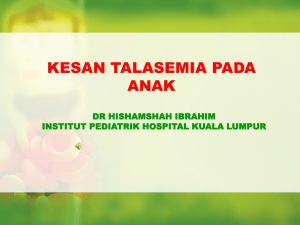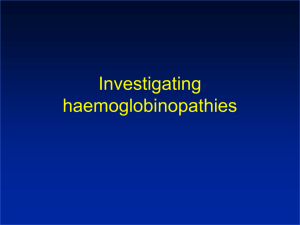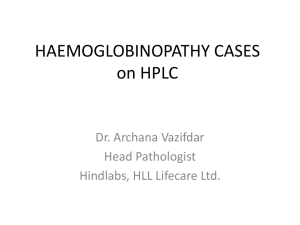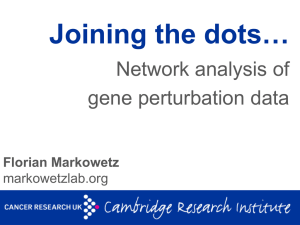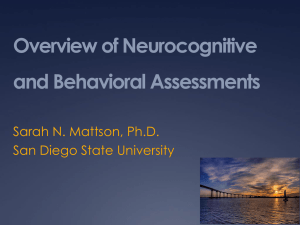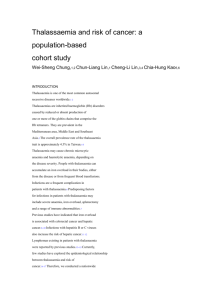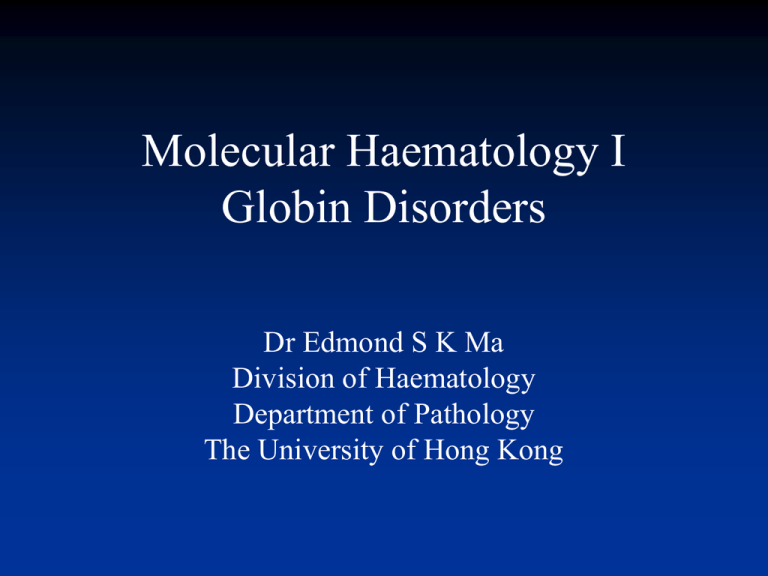
Molecular Haematology I
Globin Disorders
Dr Edmond S K Ma
Division of Haematology
Department of Pathology
The University of Hong Kong
Thalassaemia
• First described by
Thomas B. Cooley in
1925
• The term thalassaemia
was first coined in
1932 based on the
Greek word qalassa
(thalassa) meaning the
sea
Prevalence of thalassaemia in
Hong Kong Chinese
a-thalassaemia
b-thalassaemia
5%
3.1%
Prevalence of thalassaemia in
Hong Kong Chinese
a-thalassaemia
(--SEA) a-thalassaemia deletion
b-thalassaemia
codons 41-42 (-CTTT) b0
IVSII-654 (CT) b0
nt-28 (AG) b+
codon 17 (AT) b0
90%
45%
20%
16%
8%
Carrier detection
• Antenatal screening
– Obstetrical Units of the Hospital Authority
– Maternal and Child Health Centres
– Private sector
• Pre-marital and pre-pregnancy testing
– Family Planning Association
• Community based thalassaemia screening
– Children’s Thalassaemia Foundation
Detection of thalassaemia
•
•
•
•
•
Red cell indices (MCV, MCH)
Determine iron status
HPLC analysis
Hb and globin chain electrophoresis
Detection of HbH inclusion bodies
Laboratory diagnosis of
thalassaemia by HPLC
Haemoglobin electrophoresis
Detection of HbH inclusion bodies
New approaches in diagnosis of SEA deletion:
gap-PCR for SEA deletion
New approaches in diagnosis of SEA deletion:
detection of z-globin chains in adults
a-globin gene mutations
•
Deletional
(common)
--SEA
-a3.7
-a4.2
• Non-deletional (rare)
Hb CS
Hb QS
codon 30 deletion
Hb Q-Thailand
Hb Westmead
a2 codon 31
a2 codon 59
Others
Prevalence of thalassaemia in
Hong Kong Chinese (MCV < 80 fL)
a-thalassaemia
(--SEA) a-thalassaemia deletion 90%
Single a-globin gene deletion and
triplicated a-globin gene
• Prevalence
– 6% for –a3.7 and –a4.2
• Hb 13.6 ± 0.12 g/dL (11.8 – 15.6)
• MCV 83.0 ± 0.33 fL (77.9 – 88.1)
• MCH 27.2 ± 0.16 pg (24.1 – 29.7)
– 1.5% for aaaanti-3.7 and aaaanti-4.2
• Hb 13.5 g/dL, MCV 85.5 fL, MCH 28.7 pg
Single a-globin gene deletion (-a) and
triplicated a-globin gene (aaa) configuration
Molecular diagnosis of a-thalassaemia
Clark & Thein, Clin Lab Haematol 26: 159-76; 2004
• Deletions
– Gap PCR
– Southern blotting
• Non-deletional mutation: on specifically amplified
a2 or a1 genes
–
–
–
–
Restriction digest
ARMS-PCR
ASO
Direct sequence analysis
Multiplex PCR for 3 commonest
a-thalassaemia deletion
LIS1 control
a-2 gene
SEA deletion
3.7 kb deletion
4.2 kb deletion
Multiplex PCR for 3 commonest a-thalassaemia deletion
αα/--SEA
ladder
-α3.7/--SEA
-α4.2/--SEA
αα/αα
water
blank
LIS internal control
(2350 bp)
-α3.7
(2022/2029 bp)
α2
(1800 bp)
-α4.2 (1628 bp)
--SEA (1349 bp)
Restriction fragment length polymorphism (RFLP)
The principle of RFLP as shown is used to diagnose the different types of a-globin
genotypes relevant to a-thalassaemia.
Larger
fragment
Key
restriction
enzyme sites
Gel
Smaller
fragment
probe region
A typical R FLP result of different a-thal genotypes:
G en otyp es
aa/aa
B am H I
probes w ith
a-globin
B gl II
probed w ith
a-globin
aa/- a
3.7
-a
3.7
/-a
3.7
aa/ - a
4.2
-a
4.2
/-a
14.5 kb
14.5 kb;
10.5 kb
10.5 kb
14.5 kb;
10.5
10.5
12.6 kb;
7.0
16.0 kb
12.6;
7.0
16.0
12.6;
7.0
7.0
4.2
16kb
14.5kb
12.6 kb
10.5 kb
7.0 kb
Multiplex ARMS for the 3 commonest
non-deletional a2-globin gene mutations
Internal control (930 bp)
cd30(ΔGAG) (772 bp)
HbQS (234 bp)
HbCS (184 bp)
Reverse dot blot
Chan V et al, BJH 104: 513-5, 1999
Multiplex mini-sequencing screen
Wang W et al, Clin Chem 49: 800 – 803, 2003
Molecular screening of non-deletional a-globin
gene mutations by denaturing HPLC
Guida V et al, Clin Chem 50: 1242 – 1245, 2004
Thalassaemia array
Chan K et al, BJH
124: 232 – 239, 2004
Thalassaemia array
b-thalassaemia phenotypes
b-thalassaemia trait
• Aymptomatic
• Hypochromic
microcytic red cells
• High HbA2
• Variable HbF
• Genotype: simple
heterozygotes for
b-thalassaemia alleles
b-thalassaemia phenotypes
b-thalassaemia major
•
•
•
•
•
•
•
Onset < 1 year
Transfusion dependent
Many complications
Markedly HcMc RBC
Nucleated reds
Majority HbF
Genotypes: homozygous
or compound
heterozygous for
b-thalassaemia alleles
b-thalassaemia syndromes
Defining disease severity
•
•
•
•
•
•
Age at diagnosis
Steady state or lowest haemoglobin level
Age at first transfusion
Frequency of transfusion
Splenomegaly or age at splenectomy
Height and weight in percentile
Why study
genotype phenotype relationship?
• Genetic counselling
• Management decisions
Genetic factors affecting disease severity
• Nature and severity of
b-globin mutation
• Co-inheritance of
a-thalassaemia or
triplicated a-globin genes
• Genetic determinant(s) for
enhanced g-globin chain
production
Mutation detection by dot blot hybridization
Detection of five b-thalassaemia mutations by ARMS
1 2 3
4
5
6
7 8
Internal
control
-28
17
654
Internal
control
43
71-72
Panel 1:
1:
2:
3:
4:
5:
6:
1-6
-28 Heterozygote
-28/71-72 Compound Heterozygote
Codon 17 Heterozygote
Codon 43 Heterozygote
100 bp DNA Ladder
Reagent Blank Control
Panel 2:
7:
8:
7-8
IVS 2-654 Heterozygote
Reagent Blank Control
Southern blot hybridization with a-probe
PCR-based mutation detection
a-multiplex PCR
db-thalassaemia PCR
The spectrum of
b-thalassaemia alleles
in Chinese
Genotype
phenotype
correlation in
b0/b0 thalassaemia
Genotype phenotype correlation in b0/b+ thalassaemia
Homozygous b0/b0 and compound
heterozygous b0/b+ thalassaemia
Clinical phenotype of b+/b+ thalassaemia
Clinical phenotype of HbE / b-thalassemia
Molecular pathology of
b-thalassaemia
Thalassaemia intermedia: family study 1
Thalassaemia intermedia: family study 2
Thalassaemia screening using MCV and MCH cutoff
Co-inheritance of a-thalassaemia
determinants significantly ameliorates the
phenotype of severe b-thalassaemia
Yes
b0/b0 homozygotes + two a-globin gene deletion or
non-deletional a2-globin gene mutation
b+-thalassaemia homozygotes or compound
heterozygotes single a-globin gene deletion
No
b0/b0 homozygotes + single a-globin gene deletion
Co-inheritance of a-thalassaemia determinants
significantly ameliorates the phenotype of
severe b-thalassaemia
Points to note:
• Molecular heterogeneity of a-thalassaemia and b-thalassaemia alleles
results in wide range of clinical outcomes
• Small numbers of patients in each category
• Variations among different populations (e.g. in Thai patients
a-thalassaemia ameliorates severe b-thalassaemia only in the presence
of at least one b-thalassaemia allele)
Co-inheritance of a-thalassaemia in
severe b-thalassaemia
Co-inheritance of a-thalassaemia in
severe b-thalassaemia
Co-inheritance of a-thalassaemia in
severe b-thalassaemia
Conclusion
The co-inheritance of (--SEA) a-thalassaemia (SEA)
deletion ameliorates the clinical phenotype of b0/b+
but not necessarily b0/b0-thalassaemia in Chinese
patients
Co-inheritance of a-thalassaemia in
severe b-thalassaemia
Implications
1. Detection of SEA deletion in couples at risk of offspring affected by
b0/b+-thalassaemia (~ 8 / year)
2. At prenatal diagnosis, a genotype of b0/b+ -thalassaemia + SEA
deletion is predictive of thalassaemia intermedia, but the same cannot
be said for b0/b+-thalassaemia alone or b0/b0-thalassaemia + SEA
deletion
Triplicated a-globin gene in
b-thalassaemia heterozygotes
• Observed in 15% of thalassaemia intermedia, not seen in
thalassaemia major
• Presentation in adulthood
• May also be associated with a phenotype of thalassaemia
trait
Triplicated a-globin gene in
b-thalassaemia heterozygotes
Triplicated a-globin gene in
b-thalassaemia heterozygotes
• Distinction from simple b-thalassaemia heterozygotes
– Presence of red cell abnormalities
– Circulating normoblasts
– More anaemic
– Higher HbF levels
• Explain the inheritance of families in which only one
parent is thalassaemic
Triplicated a-globin gene in
b-thalassaemia heterozygotes
Genetic basis for phenotypic
variation in the Chinese
• Severity of b-thalassaemia mutation
b0/b0
b0/b+
b0/b+++
b/b+
severe
2/3 severe; 1/3 intermedia
intermedia
intermedia (mild)
• Concurrent a-thalassaemia
SEA deletion ameliorate b0/b+ only but not necessarily b0/b0
• Triplicated a-globin gene in b-thalassaemia
heterozygotes
Often associated with thalassaemia intermedia phenotype
Genetic basis for phenotypic
variation in the Chinese
• Determinants of HbF production
– XMnI Gg-promoter polymorphism: inconsistent
effect
– Familial determinants of high HbF remains to be
defined
Effect of XMnI Gg-promoter polymorphism
Genotype
phenotype
correlation in
b0/b0 thalassaemia
Genetic determinants of high HbF
Genetic determinants of high HbF
Subject
Sex/Age
Hb
(g/dL)
MCV
(fL)
MCH
(pg)
HbA2
(%)
HbF
(%)
HbH
bodies
α-genotype
β-genotype
Index
F/42
8.2
61.3
21.8
4.5
34.9
Negative
ζζζαα/ζζαα
β41/42(-CTTT)/βA
Elder
brother 1
M/52
11.8
59.9
20.3
5.8
0.8
Negative
ζζζαα/ζζαα
β41/42(-CTTT)/βA
Elder
brother 2
M/46
11.4
58.3
19.2
4.8
45.3
Negative
ζζζαα/ζζαα
β41/42(-CTTT)/βA
Elder
Sister
F/48
12.6
91.5
29.9
2.2
13.3
Negative
ζζαα/ζζαα
βA/ βA
Daugther
F/13
10.5
60.2
19.6
5.7
0.8
Negative
ζζαα/ζζαα
β41/42(-CTTT)/βA
Son of
elder
brother 2
M/12
12.3
62.3
18.3
5.6
1.5
Negative
ζζαα/ζζαα
β41/42(-CTTT)/βA
Note: All subjects are negative for XmnI Gγ-polymorphism
Agb-HPFH:
nt -196 C→T
Genetic modifiers of
single gene disorders
Primary modifiers
Secondary modifiers
Tertiary modifiers
Hyperbilirubinaemia
Jaundice
Gall stones
UGT1A1 mutations and
hyperbilirubinaemia
• Uridine-diphosphoglucuronate glucuronosyltransferase
– UGT1 gene : 12 isoforms with alternative first exons
– UGT1A1 contributes most significantly to bilirubin
glucuronidation
– Mutations in coding region and promoter
UGT1A1 alleles in Chinese
Hsieh S-Y et al, Am J Gastroenterol 96: 1188 - 1193, 2001
Detection of UGT1A1 polymorphisms
• UGT1A1 promoter genotype
– direct sequencing of PCR product
• Gly71Arg mutation at exon 1
– PCR restriction analysis of MspI cleavage site
Homozgyous (TA)6
MA B
C
143bp
119bp
143b
p
119b
24bpp
24bp
Heterozgyous (TA)6/(TA)7
M W h W W W W H h h W W H
Homozgyous (TA)7
Prevalence of UGT1A1 polymorphisms
(TA)7 = 25 cases (19.6%); G71R = 34 cases (26.8%)
Major
Intermedia
(TA)7 homozygous
(TA)7 heterozygous
0
14 (2)
2
9 (1)
G71R homozygous
G71R heterozygous
4
24 (2)
2
4 (1)
Predictors of bilirubin level
Predictors of gall stones
Genetic haemochromatosis and
iron overload in b-thalassaemia
• Homozygosity for HFE alleles C282Y and
H63D
– predisposes to iron overload in b-thalassaemia
• Prevalence in Chinese patient cohort
Allele
C282Y
H63D
S65C
Frequency
0%
1.3%
0%
Transferrin receptor-2 (TFR2)
mutations and iron overload
• Homologue of transferrin receptor with 48%
identity and 66% similarity
• Common affinity for diferric transferrin
• Lack of affinity for HFE protein
Transferrin receptor-2 (TFR2)
polymorphisms
• Allelic frequency
Polymorphism
Patients
Control
p-value
exon 5 I238M
IVS16+251 -CA
7.1%
24.5%
4.7%
22.2%
0.24
0.54
TFR2 polymorphism and iron overload in
transfusion independent b-thalassaemia intermedia
Genetics of osteoporosis in
thalassaemia
• Heterozygous (Ss) or homozygous (ss) polymorphism of
COLIA1 gene: ↓ BMD
– Perrotta et al, Br J Haematol 111: 461, 2000
• VDR BB genotype: ↓ spine BMD than bb genotype
– Dresner Pollak et al, Br J Haematol 111: 902, 2000
• VDR FF genotype: shorter stature and ↓ BMD
– Ferrara et al, Br J Haematol 117: 436, 2002
Conclusions
• Disease severity explainable by nature of
b-thalassaemia mutation and interacting
a-thalassaemia
• Problem of discordant phenotype in b0/b+
• Genetic modifiers may play in role in modulating
phenotype (especially complications)

